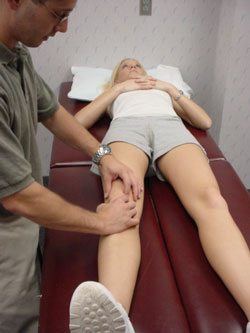
To date, numerous research has been conducted on the efficacy of patellofemoral taping with conflicting results. For every study that shows altered patella kinematics, enhanced EMG and muscle function, improved dynamic alignment, and decreased patellofemoral joint reaction forces, there seems to be another study that shows just the opposite. One thing is certain, though, most studies do tend to agree that patellar taping decreases pain in patellofemoral pain syndrome patients (PFPS). The question is, why?
Patellar Taping – A Possible Reason as to Why it Works?
A study was published earlier this year that I think explains the mechanism by which patellar taping may work. Actually, the authors of the study didn’t mention this mechanism at all in the paper and it really wasn’t what they studied, but after I read the article, I had one of those “Ah-Ha” moments! I’ll explain later, but first let’s discuss the article.
McConnell Taping and Dynamic MRI
A recent study by Derasari et al in the Journal of Physical Therapy sought to examine patellar kinematics in patellofemoral pain patients after McConnell taping using dynamic MRI. This is the first study to assess patellofemoral kinematics in 6-degrees-of-freedom during active knee extension.
14 subjects that had PFPS for greater 1 year were included in the study and underwent dynamic MRI during active knee extension with and without patellar taping. Standard McConnell taping was apply in the lateral-to-medial direction in an attempt to glide the patella medially, such as in this photo:
Results of the study showed that patellar taping produced a significant shift of the patella in the inferior direction, not medial. In fact, the study demonstrated that not all patients with PFPS had a laterally displaced patella to begin with, some were medially displaced. However (and this is when the light bulb went off for me), those with a medially displaced patella actually saw a lateral shift in patella position after taping, even though the tape was applied in the standard lateral-to-medial direction. The patella shifted against the tape direction! This is also probably why there is so much conflicting research in the literature.
Why Patellar Taping Really Works
This study was a big “Ah-Ha” moment for me, and I think we may have found a viable reason to explain why patellofemoral taping works. Think about it, patellar taping in the lateral-to-medial direction did cause a medial shift in the patella for those that were laterally displaced, but it produced just the opposite in people that were medially displaced, the patella actually moved against the direction of taping. Why?
After reading this study I think that taping doesn’t shift the patella in one direction, what it does is compress the patellofemoral joint. Take a look at the figures below. The figure on the left shows a patellofemoral joint with a laterally displaced patella, it does not sit centered within the trochlea groove. The figure to the right is that same knee, but now with patellar tape (orange line) applied. As you can see, it centers the patella within the groove but compressing it, the patella glides against the ridge of the trochlea:

The same holds true for the medially displaced patella, even if you tape in the lateral-to-medial direction, it doesn’t matter, the patellar actually shifts laterally in this case because again is glides with the trochlea groove:


It is well documented that a displaced patella causes the patellofemoral contact area to decrease, causing the same amount of force to be applied to a more focal area. By centering the patella within the trochlea, this force is distributed across a larger surface area and stress on the cartilage is decreased (for more information on this, subscribe to my newsletter and read my free eBook Solving the Patellofemoral Mystery). As you can see in the below figures, if the same amount of force is applied to a larger area of contact, the force is distributed more evenly across the cartilage:

Obviously, more research needs to be conducted, but this hypothesis seems to have some potential validity and may explain why why patellar taping works and why there is so much conflict in the literature. If you like this kind of thing like I do, read my eBook Solving the Patellofemoral Mystery, free to all my newsletter subscribers.
Based on your experience, do you agree? Think differently? Why do you think patellar taping works?









